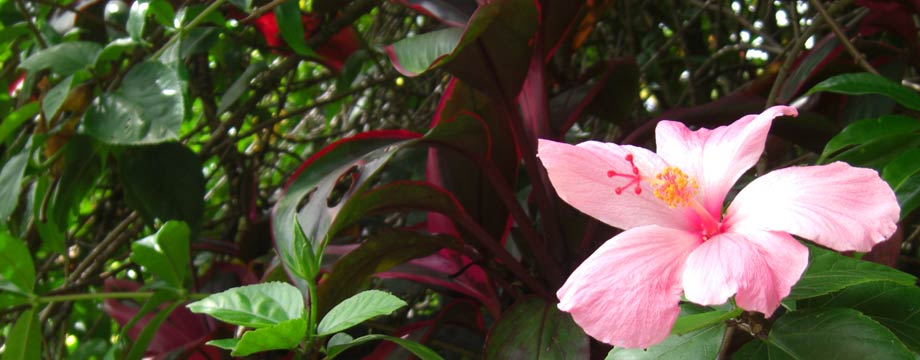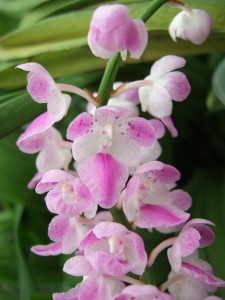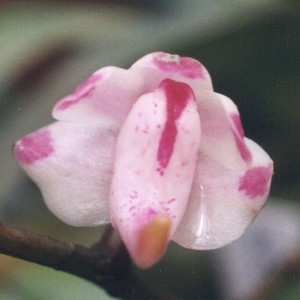Benjamin Williams wrote of the orchid genus Aerides, “The species of Aerides are among the most beautiful of Orchids, many of them uniting every good quality that a plant can possess, viz., rich, evergreen, and regularly curved foliage; a graceful habit, flowers deliciously scented, and of peculiar elegance. Even when not in bloom the plants themselves are interesting objects, and give a tropical character to the collections in which they are found. The stems of Aerides are straight or slightly bent, with leaves attached on opposite sides, and they are nourished by large fleshy roots, shooting out horizontally from the lower part of the stem. The flowers, which are rich and waxy, proceed from the axils of the leaves and extend in delicate racemes one or two feet in length, while their fragrance is so powerful as to fill the house in which they grow with grateful perfume.
“These plants are of easy culture, and if properly attended to seldom fail to do well. They are found in various parts of India and in the islands of the Indian Archipelago, growing on the branches of trees, generally on such as overhang streams of water; and to grow them in anything like perfection, the climate in which they grow wild must be imitated in most respects. I find they succeed best with a good supply of heat and moisture during their growing season, which is from about March to the latter end of October. During that time I keep the temperature, by day, from 70° F to 75° F. It may be allowed to rise to 80° F and 85° F, or even higher will not do any harm, provided the house is shaded from the rays of the sun. The night temperature should range from 65° F to 70° F in March and April, and afterwards it may rise five degrees higher. In the autumn and winter months let the temperature average from 60° F to 65° F by night, and by day a little more will be of benefit to them; they like a liberal supply of moisture about their roots, but bear in mind not to give them it in dull weather.
“Some grow their Aerides in baskets made of wood, but they may also be grown in pots—a mode of culture successfully followed by many of our Orchid growers, especially those who exhibit; for when in pots, the plants are more easily moved about. Another reason in favour of pot culture is that baskets soon decay; but if the plants are not required for exhibition, I should advise some of the smaller kinds to be grown in baskets, in which they have a fine appearance, especially if there is room for suspending them, letting the roots grow out of the basket. All the kinds will succeed well in this way. In pot culture till the pots about three parts full of potsherds, large piece sat the bottom, but finish off at the top with small; above this fresh living sphagnum moss should be used, and when the moss begins to decay fresh should be given to keep all healthy. They all do well on blocks of wood, but to grow them in perfection they require care as regards moisture. Sphagnum moss and broken potsherds have proved the best materials for filling baskets. They require frequent watering at the roots during the growing season; indeed, they should never he allowed to become thoroughly dry, not even during their season of rest, as they are liable to shrivel and lose their bottom leaves. Aerides require but little repose, and the moss should always be kept damp; but during the dull months of winter no water should be allowed to lodge on the leaves or in the heart of the plant, as it would be very apt to rot them. The plants, if not in pots, should be suspended from the roof, but not very near the glass, lest they should be affected by cold; and they should be kept perfectly free from insects, especially the different kinds of scale. There is a small kind in particular which is apt to infest them, and which, if allowed to increase, will speedily make the plants look yellow and unhealthy. It may be kept under by washing with warm water and soft soap, applied with a sponge and left on the leaves for some twenty-four hours, when all remains of the soap should be removed with clean water.
“These plants are propagated by cutting them into pieces, with roots attached to each piece. Some kinds, however, are shy in throwing up young shoots, and this makes these sorts very scarce. The Aerides odoratum division is the most easy to increase, and Aerides crispum sends out roots more freely than some others. If the plants ever get into an unhealthy condition, the best way is to cut off the bottom of the plant, and give fresh moss, with plenty of water at the roots.”
- Aerides affine (see Aerides multiflora)
- Aerides crassifolia (alternative spelling: Aerides crassifolium)
- Aerides crispa (alternative spelling: Aerides crispum)
- Aerides cylindricum (see Papilionanthe vandarum)
- Aerides × dominianum
- Aerides falcata
- Aerides fieldingii (see Aerides rosea)
- Aerides japonicum (see Sedirea japonica)
- Aerides larpentae (see Aerides falcata)
- Aerides lobbii (see Thrixspermum calceolus)
- Aerides maculosa (alternative spelling: Aerides maculosum)
- Aerides McMorlandi
- Aerides margaritaceum
- Aerides mendelii (see Aerides falcata)
- Aerides mitratum (see Seidenfadenia mitrata)
- Aerides multiflora
- Aerides nobile (see Aerides odorata)
- Aerides odorata (alternative spelling: Aerides odoratum)
- Aerides quinquevulnera (see Aerides quinquevulnerum)
- Aerides rosea (alternative spelling: Aerides roseum)
- Aerides rubrum (see Aerides odorata)
- Aerides suavissimum (see Aerides odorata)
- Aerides testaceum
- Aerides thibautianum
- Aerides veitchii (see Aerides multiflora)
- Aerides virens
- Aerides williamsii (see Aerides rosea)
Type Species
Aerides odorata is the type species for the genus Aerides.



